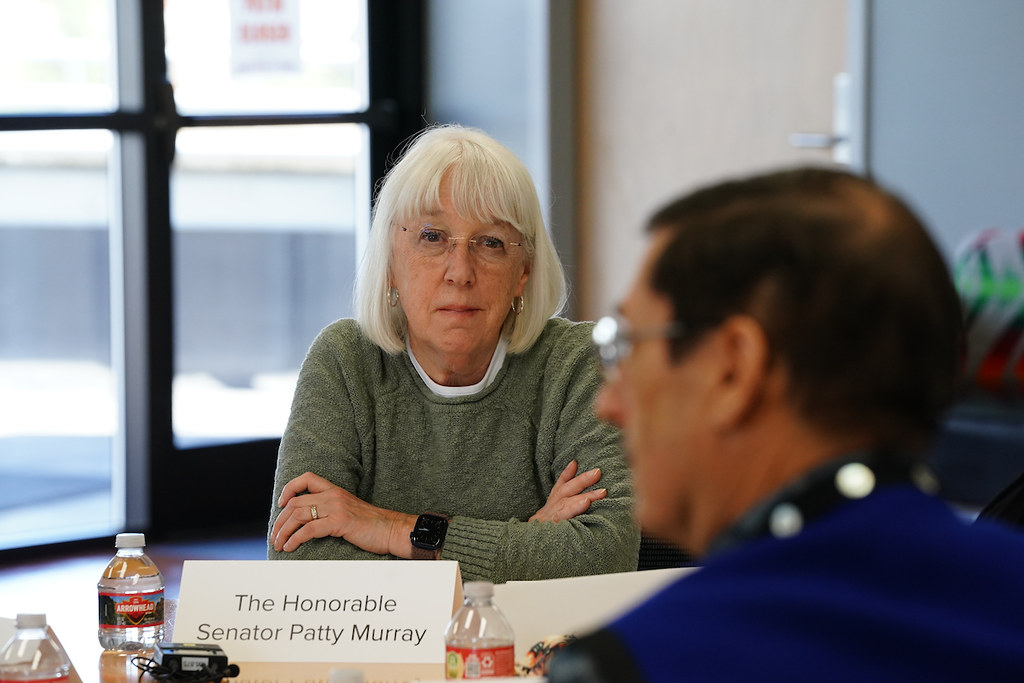In the government funding bills Murray negotiated, she secured $1.47 million for WSU Spokane to build out their Indigenous Health Simulation Center to help train health care workers and improve health outcomes for Indigenous patients
Murray protected funding for Indian Health Service (IHS) despite tight budget caps, provided advance appropriations to give IHS greater certainty and prevent disruptions in care
***PHOTOS AND B-ROLL from visit HERE***
Spokane, WA – Today, U.S. Senator Patty Murray (D-WA), Chair of the Senate Appropriations Committee, visited Washington State University (WSU)’s Native American Health Sciences Center in Spokane to see firsthand how $1.47 million in federal funding she secured in the appropriations bills that were signed into law in March will support the development of an Indigenous Health Simulation Center (IHSC) that will provide research-informed and scalable models to support better health outcomes for the 29 federally-recognized Tribes within Washington State. This is believed to be the nation’s first Indigenous-developed and instructed clinical simulation space.
During the visit, Murray toured the Center for Native American Health, including the student center and the current simulation (“sim”) space and heard from WSU faculty and medical students about the development of the IHSC and the expansion they are planning with funding Murray secured. After the tour, Murray met with members of the Tribal Advisory Board to discuss the impact the IHSC will have in the training of our future health care workforce, and the importance of efforts to achieve better health outcomes for Indigenous populations.
The funding Murray secured to expand the IHSC will go specifically toward facility construction, acquisition of simulation equipment, and development of the infrastructure needed to support in-person and online education to strengthen the knowledge and skillsets of providers and foster collaboration to improve health equity for Indigenous populations. The IHSC will be critical for properly training culturally knowledgeable and skilled health care workers who can achieve better health outcomes for Indigenous patients and communities. Utilizing advanced remote access technology, WSU is planning to make this model of Native American patient-centered training available throughout the state and across the country.
“It’s great to see up close the incredible work happening here at the Native American Health Sciences Center and to hear about how funding I secured is going to support that work by expanding the Indigenous Health Simulation Center,” said Senator Murray. “The brutal reality is that our health care system does not work for everyone—entrenched bias and outright racism have led to tragic failures for communities of color, especially for Tribes. Tribal patients frequently have to travel farther for care and face cultural barriers, financial barriers, and of course discrimination and bias. And all of that adds up to some devastating health outcomes—a lower life expectancy by five and half years, and higher rates of many devastating conditions. At this center, WSU is training a new generation of providers in culturally competent care and building our health workforce in underserved Tribal communities. WSU’s plans to connect students nationwide to these resources means they won’t just benefit Tribes in Washington state, it will help communities across the country. Projects like this make me truly proud to be a Coug!”
American Indians and Alaska Natives born today have a life expectancy that is 5.5 years shorter than the overall U.S. population and die at higher rates from conditions including chronic liver disease and cirrhosis, diabetes, and chronic lower respiratory diseases. Issues of implicit bias and a shortage of a culturally knowledgeable and proficiently skilled health workforce contribute to these inequities. Washington state is one of few states with a law requiring continuing education units for health equity among health care providers, however, existing state infrastructure is inadequate for developing and deploying necessary approaches to support closing these health disparity gaps for Indigenous populations. Key to addressing these disparities is improving provider-patient engagements, increasing and sustaining visitation rates, improving provider retention in rural and underserved health systems, and enhancing the quality of care for Indigenous patients—all goals the IHSC will help support.
“This space is an investment in a future where our health care workforce is equipped with the skills necessary to avoid unintended implicit bias and missteps when providing care to Native populations, using culturally-centered knowledge and practices,” said Dr. Naomi Bender, director of WSU Spokane’s Native American Health Sciences program. “We are grateful to Senator Murray for her continued support in helping bring our vision to life—to balance the long-held primary focus of western medicine’s approach to patient care education with bridging indigenous frameworks and perspectives of healing, so they may co-exist and better serve communities.”
Senator Murray, the former Chair of the Senate Health, Education, Labor, and Pensions (HELP) Committee, has fought for decades to improve access to quality health care and lower costs, and this year as Appropriations Chair she protected funding for the Indian Health Service (IHS) despite tough budget caps and fought for—a $61.4 million increase to ensure IHS can hire more providers to meet increased patient demand. Importantly, Murray secured advance appropriations for IHS to provide more certainty and limit disruptions so the agency can better plan and provide continuity of care for Tribes. Senator Murray also secured additional wins for WSU, her alma mater, in the government funding legislation she negotiated including: $7.642 million for WSU to design, construct, and purchase equipment for a new nuclear hot cell facility; $2.5 million for WSU to upgrade a transmission electron microscope; and additional funding for the Agricultural Research Service including $6.3 million for critical research to help Washington state farmers, much of which takes place at WSU.
###


